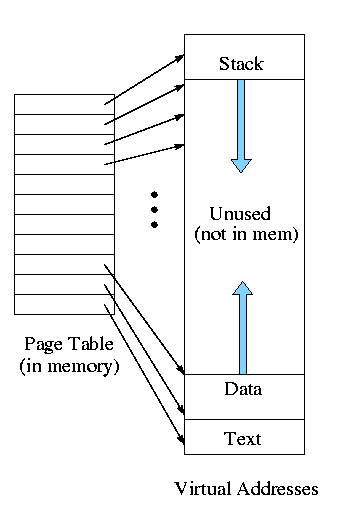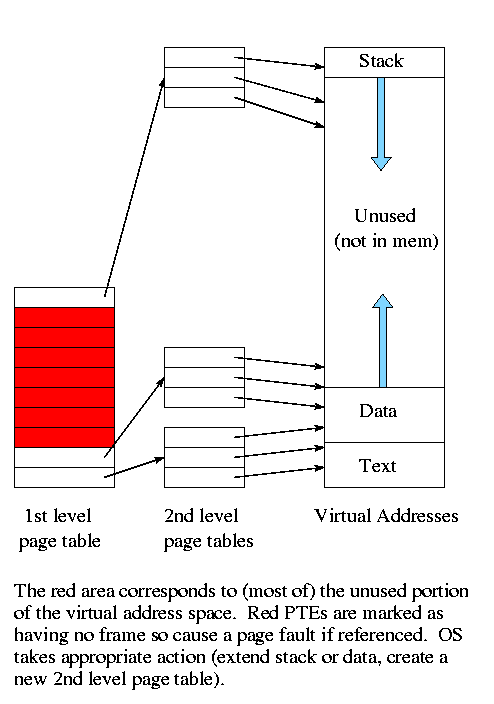================ Start Lecture #11
================
3.3.2: Page tables
A discussion of page tables is also appropriate for (non-demand)
paging, but the issues are more acute with demand paging since the
tables can be much larger. Why?
Ans: The total size of the active processes is no longer limited to
the size of physical memory.
Want access to the page table to be very fast since it is needed for
every memory access.

Unfortunate laws of hardware
- Big and fast are essentially incompatible
- Big and fast and low cost is hopeless
So we can't just say, put the page table in fast processor registers
and let it be huge and sell the system for $1500.
Put the (one-level) page table in main memory.
- Too slow
- TLB would help as mentioned
above (discussed later in more detail).
- Too big
- Currently we are considering contiguous virtual
addresses ranges (i.e. the virtual addresses have no holes).
- Typically put the stack at one end of virtual address and the
global (or static) data at the other end and let them grow towards
each other
- The memory in between is unused.
- This unused memory can be huge (in address range) and hence
the page table will mostly contain unneeded PTEs
- Works fine if the virtual address range possible is small, which
was once true but no longer (e.g. of PDP-11 in Tanenbaum).
Protection bits
Can place protection bits on pages. For example can mark pages as
execute only. This requires that boundaries between regions with
different protection must be on page boundaries. Protection is more
naturally done with segmentation.

Multilevel page tables
The idea, which is also used in Unix inode-based file systems, is to
add a level of indirection and have a page table containing pointers
to page tables. This topic will not be on the 202 midterm or final.
- Imagine one big page table.
- Call it the second level page table and
cut it into pieces each the size of a page.
Note that you can get many PTEs in one page so you will have far
fewer of these pages than PTEs
- Now construct a first level page table containing PTEs that point to
these pages.
- This first level PT is small enough to store in memory.
- But since we still have the 2nd level PT, we have made the world
bigger not smaller!
- Don't store in memory the 2nd level page tables all of whose PTEs
refer to unused memory. That is use demand paging on the (second
level) page table
Do an example on the board
The VAX used a 2-level page table structure, but with some wrinkles
(see Tanenbaum for details).
Naturally, there is no need to stop at 2 levels. In fact the SPARC
has 3 levels and the Motorola 68030 has 4 (and the number of bits of
Virtual Address used for P#1, P#2, P#3, and P#4 can be varied).
3.3.4: Associative memory (TLBs)
Note:
Tanenbaum suggests that ``associative memory'' and ``translation
lookaside buffer'' are synonyms. This is wrong. Associative memory
is a general structure and translation lookaside buffer is a special
case.
An
associative memory is a content addressable
memory. That is you access the memory by giving the value
of some field and the hardware searches all the records and returns
the record whose field contains the requested value.
For example
Name | Animal | Mood | Color
======+========+==========+======
Moris | Cat | Finicky | Grey
Fido | Dog | Friendly | Black
Izzy | Iguana | Quiet | Brown
Bud | Frog | Smashed | Green
If the index field is Animal and Iguana is given, the associative
memory returns
Izzy | Iguana | Quiet | Brown
A Translation Lookaside Buffer
or TLB
is an associate memory
where the index field is the page number. The other fields include
the frame number, dirty bit, valid bit, and others.
-
A TLB is small and expensive but at least it is
fast. When the page number is in the TLB, the frame number
is returned very quickly.
-
On a miss, the page number is looked up in the page table. The record
found is placed in the TLB and a victim is discarded. There is no
placement question since all entries are accessed at the same time.
But there is a replacement question.
Homework: 15.
3.3.5: Inverted page tables
Keep a table indexed by frame number with the entry f containg the
number of the page currently loaded in frame f.
- Since modern machine have a smaller physical address space than
virtual address space, the table is smaller
- But on a TLB miss, must search the inverted page table.
- Would be hopelessly slow except that some tricks are employed.
- The book mentions some but not all of the tricks, we are skipping
this topic.
3.4: Page Replacement Algorithms
These are solutions to the replacement question.
Good solutions take advantage of locality.
- Temporal locality: If a word is referenced now,
it is likely to be referenced in the near future.
- This argues for caching referenced words, i.e. keeping the
referenced word near the processor for a while
- Spatial locality: If a word is referenced now,
nearby words are likely to be referenced in the near future.
- This argues for prefetching words around the currently
referenced word.
- These are lumped together into locality: If a
page is referenced, it is likely to be referenced in the near future.
- So it is good to bring in the entire page on a miss and to
keep the page in memory for a while.
-
When programs begin there is no history so nothing to base
locality on. At this point the paging system is said to be undergoing
a ``cold start''.
-
Programs exhibit ``phase changes'', when the set of pages referenced
changes abruptly (similar to a cold start). At the point of a phase
change, many page faults occur because locality is poor.
Pages belonging to processes that have terminated are of course
perfect choices for victims.
Pages belonging to processes that have been blocked for a long time
are good choices as well.
Random
A lower bound on performance. Any decent scheme should do better.
3.4.1: The optimal page replacement algorithm (opt PRA)
Replace the page whose next
reference will be furthest in the future
- Also called belady's min algorithm
- Provably optimal. That is, generates the fewest number of page
faults.
- Unimplementable: Requires predicting the future.
- Good upper bound on performance
3.4.2: The not recently used (NRU) PRA
Divide the frames into four classes and make a random selection from
the lowest nonempty class.
- Not referenced, not modified
- Not referenced, modified
- Referenced, not modified
- Referenced, modified
Assumes that in each PTE there are two extra flags R (sometimes called
U, for used) and M (often called D, for dirty).
Also assumes that a page in a lower priority class is cheaper to evict
- If not referenced, probably not referenced again soon so not so
important.
- If not modified, do not have to write it out so the cost of the
eviction is lower
-
When a page is brought in, OS resets R and M (i.e. R=M=0)
-
On a read, hardware sets R
-
On a write, hardware sets R and M
We again have the prisoner problem, we do a good job of making little
ones out of big ones, but not the reverse. Need more resets
Every k clock ticks, reset all R bits
- Why not reset M?
Ans: Must have M accurate to know if victim must be written back
- Could have two M bits one accurate and one reset, but I don't know
of any system (or proposal) that does so.
What if hardware doesn't set these bits?
-
OS can use tricks
-
When the bits are reset, make the PTE indicate the page is not
resident (i.e. lie). On the page fault, set the appropriate bit(s).
3..4.3: FIFO PRA
Simple but poor since usage of the page is ignored.
Belady's Anomaly: Can have more frames yet more
faults.
Example given later.
3.4.4: Second chance PRA
Fifo but when time to choose a victim if page at the head of the queue
has been referenced (R bit), don't evict it. Instead reset R and move
the page to the rear of the queue (so it looks new). The page is
being a second chance.
What if all frames have been referenced?
Becomes the same as fifo (but takes longer).
Might want to turn off the R bit more often (k clock ticks).
3.4.5: Clock PRA
Same algorithm as 2nd chance, but a better (and I would say obvious)
implementation: Use a circular list.
Do an example.


